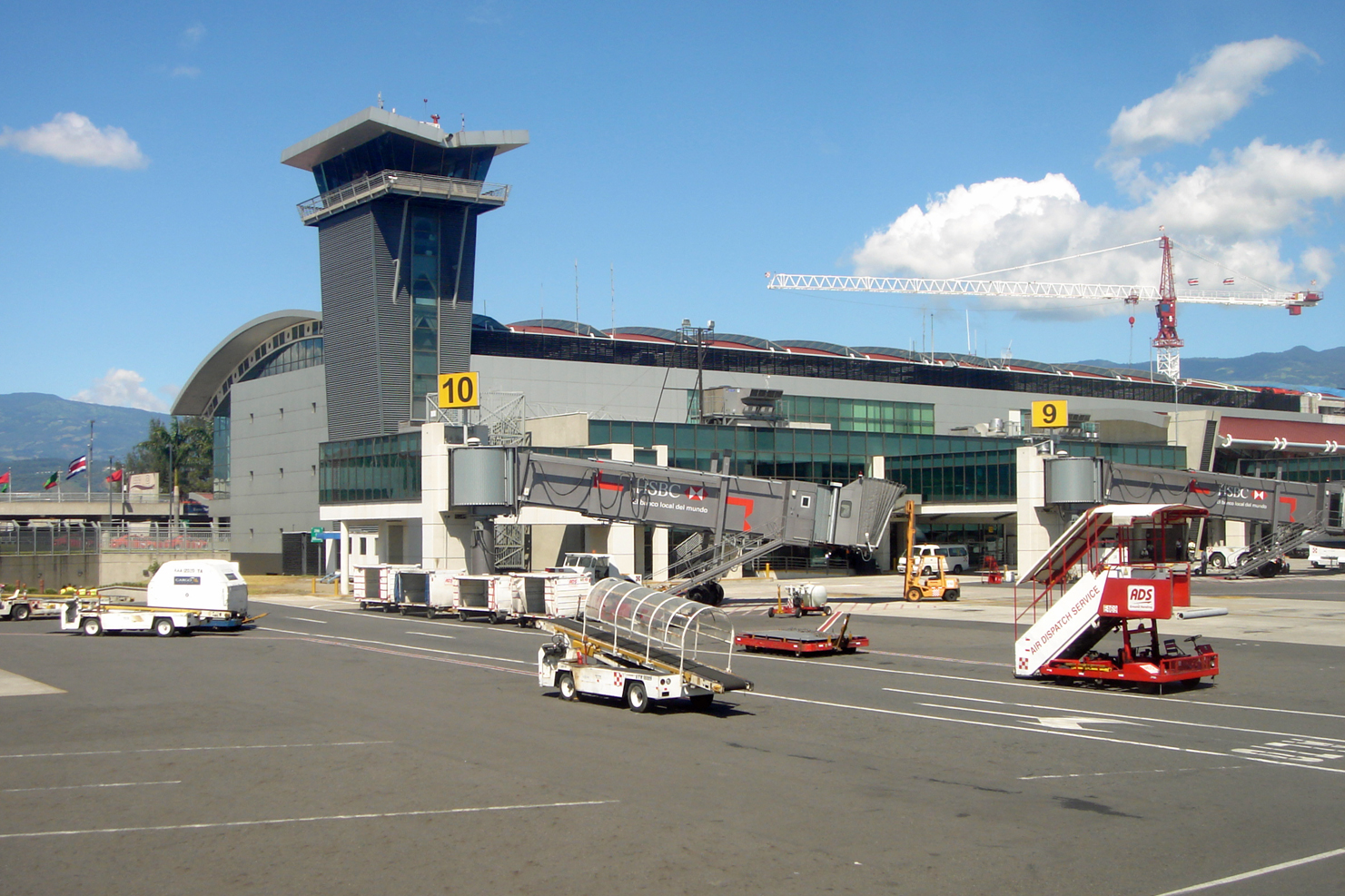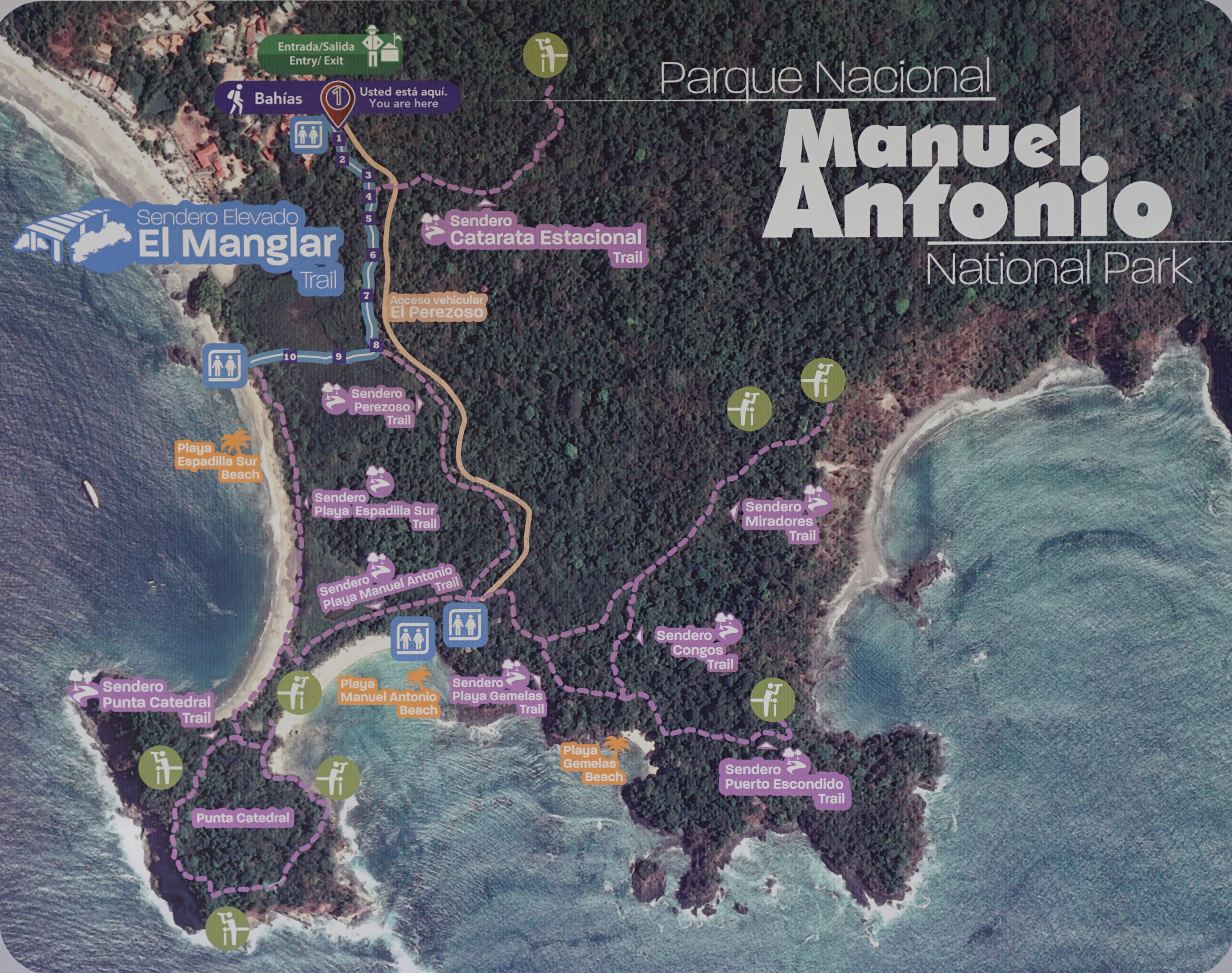|
Jacó, Costa Rica
Jacó is a district of the Garabito canton, in the Puntarenas province of Costa Rica. Jacó has a black sand beach that is long and is popular among surfers. History Jacó was created on 16 September 1965. Segregated from Puntarenas. Geography Jacó has an area of km² and an elevation of metres. Jacó lies between several mountains, and is neighbored by the beaches of Herradura Bay to the North, and Playa Hermosa to the South (not to be confused with another beach by the same name, but located in Guanacaste). About 35 kilometers north of Jacó, lies the Carara National Park, recognized for its exuberant wildlife and dense rain forest. Carara is home to one of the largest remaining populations of wild scarlet macaws in the country. The Manuel Antonio National Park is located 75 kilometres south of Jacó. Jacó lies about 100 kilometers (a little less than two hours via Route 34) from the capital San José and an hour and a half from Costa Rica's primary internatio ... [...More Info...] [...Related Items...] OR: [Wikipedia] [Google] [Baidu] |
Districts Of Costa Rica
According to the Administrative divisions of Costa Rica, Territorial Administrative Division the Cantons of Costa Rica, cantons of Costa Rica are subdivided into 488 districts (''distritos''), each of which has a unique five digit postal code. Government organization Each canton is divided into districts whose number varies from canton to canton. Each district has a District Council chaired by a syndic, all popularly elected. The District Council is the interlocutor between the district and the municipal government and ensures the communal and neighborhood interests before the Municipal Council; although the direct administration of the district falls to the municipality, the District Councils also exercise administrative functions such as forwarding projects to the Council and supervising the work of the mayor. District Municipal Council There are eight District Municipal Councils (), in districts that area geographically distant from the head city of the canton where the mu ... [...More Info...] [...Related Items...] OR: [Wikipedia] [Google] [Baidu] |
Scarlet Macaw
The scarlet macaw (''Ara macao'') is a large red, yellow, and blue Central and South American parrot, a member of a large group of Neotropical parrots called macaws. It is native to humid evergreen forests of the Neotropics. Its range extends from south-eastern Mexico to Peru, Ecuador, Colombia, Bolivia, Venezuela and Brazil in lowlands of (at least formerly) up to , the Caribbean island of Trinidad, as well as the Pacific island of Coiba. Formerly, it ranged north to southern Tamaulipas. In some areas, it has suffered local extinction because of habitat destruction, or capture for the parrot trade, but in other areas, it remains fairly common. It is the national bird of Honduras. Like its relative the blue-and-yellow macaw, the scarlet macaw is a popular bird in aviculture as a result of its striking plumage. Taxonomy The scarlet macaw was formally described by the Swedish naturalist Carl Linnaeus in 1758 in the tenth edition of his ''Systema Naturae'' under the binomial name ' ... [...More Info...] [...Related Items...] OR: [Wikipedia] [Google] [Baidu] |
Surfing
Surfing is a surface water sport in which an individual, a surfer (or two in tandem surfing), uses a board to ride on the forward section, or face, of a moving wave of water, which usually carries the surfer towards the shore. Waves suitable for surfing are primarily found on ocean shores, but can also be found in standing waves in the open ocean, in lakes, in rivers in the form of a tidal bore, or in wave pools. The term ''surfing'' refers to a person riding a wave using a board, regardless of the stance. There are several types of boards. The Moche of Peru would often surf on reed craft, while the native peoples of the Pacific surfed waves on alaia, paipo, and other such water craft. Ancient cultures often surfed on their belly and knees, while the modern-day definition of surfing most often refers to a surfer riding a wave standing on a surfboard; this is also referred to as stand-up surfing. Another prominent form of surfing is body boarding, where a surfer rides ... [...More Info...] [...Related Items...] OR: [Wikipedia] [Google] [Baidu] |
CR RNP 34
CR or Cr may refer to: In business * Conversion rate, in marketing * Credit Record, in accounting * Crown Royal, a brand of Canadian whisky Organizations Religious organizations * Celtic reconstructionism, a form of Polytheism * Congregation of Clerics Regular of the Divine Providence (Theatines), a Roman Catholic religious order * Community of the Resurrection, an Anglican religious order * Congregation of the Resurrection, a Catholic religious order Other organizations * Choose Responsibility, a US non-profit addressing alcohol consumption by young adults * College of the Redwoods, a public two-year community college in Humboldt County, California, US * College Republicans, a college branch of the US political party * Czech Radio, a public radio broadcaster in the Czech Republic People * C. Rajagopalachari, Indian politician * Christina Ricci, American actress * Chris Rock, American comedian and actor * Cristiano Ronaldo, Portuguese footballer * Christopher Reeve, American act ... [...More Info...] [...Related Items...] OR: [Wikipedia] [Google] [Baidu] |
Costa Rica 2011 Census
The Costa Rica 2011 Census was undertaken by the National Institute of Statistics and Census (''Instituto Nacional de Estadística y Censos'' (INEC)) in Costa Rica. The semi-autonomous government body, INEC, was created by Census Law No. 7839 on 4 November 1998. The census The census took place between Monday, 30 May 2011 and Friday, 3 June 2011 when 35,000 enumerators, mostly teachers, visited an estimated 1,300,000 households to count a population estimated before the census at about 4,650,000 individuals (the census itself counted 4,301,712 people).Semana del Censo Nacional: INEC pide a la población responder el Censo Instituto Nacional de Estadística y Censos, Costa Rica, 2011-05-31. [...More Info...] [...Related Items...] OR: [Wikipedia] [Google] [Baidu] |
National Route 27 (Costa Rica)
National Primary Route 27, or just Route 27 ( es, Ruta Nacional Primaria 27, or ) is a National Road Route of Costa Rica, is a route which connects the Greater Metropolitan Area to Caldera Port and the Pacific coast of the country. There are two named segments, from San José to Santa Ana the name is , and from Santa Ana to Caldera the name is (José María Castro Madriz National Road), also known as (San José-Caldera Highway), Description The design of the route dates from 1978, due to financial, political and bad management, it was opened thirty-two years later, in several segments since 2005. The route begins next to the National Gymnasium in Mata Redonda district of San José canton, and continues west with four lanes, two in each direction, then from the loop road Route 39 to the toll booths in Escazú there are six lanes, three in each direction. Afterward, until Ciudad Colón there are four lanes, two in each direction, then only two lanes, one in each direction ... [...More Info...] [...Related Items...] OR: [Wikipedia] [Google] [Baidu] |
Juan Santamaría International Airport
Juan Santamaría International Airport ( es, Aeropuerto Internacional Juan Santamaría) is the primary airport serving San José, the capital of Costa Rica. The airport is located in the city of Alajuela, 20 km (12 miles) west of downtown San José. It is named after Costa Rica's national hero, Juan Santamaría, a drummer boy who died in 1856 defending his country against forces led by American filibuster William Walker. The airport is a hub for Avianca Costa Rica, Costa Rica Green Airways, Sansa Airlines, and Volaris Costa Rica and a focus city for Copa Airlines. It was the country's only international gateway for many years, but now there is also an international airport in Liberia, Guanacaste. Both airports have direct flights to North and Central America and Europe, but Juan Santamaría International Airport also serves cities in South America and the Caribbean. Juan Santamaría International Airport was once the busiest airport in Central America, but is curre ... [...More Info...] [...Related Items...] OR: [Wikipedia] [Google] [Baidu] |
San José, Costa Rica
San José (; meaning "Saint Joseph") is the capital and largest city of Costa Rica, and the capital of the province of the same name. It is in the center of the country, in the mid-west of the Central Valley, within San José Canton. San José is Costa Rica's seat of national government, focal point of political and economic activity, and major transportation hub. San José Canton's population was 288,054 in 2011, and San José's municipal land area is 44.2 square kilometers (17.2 square miles), with an estimated 333,980 residents in 2015. Together with several other cantons of the central valley, including Alajuela, Heredia and Cartago, it forms the country's Greater Metropolitan Area, with an estimated population of over 2 million in 2017. The city is named in honor of Joseph of Nazareth. Founded in 1736 by order of Cabildo de León, the population of San José rose during the 18th century through the use of colonial planning. It has historically been a city of strat ... [...More Info...] [...Related Items...] OR: [Wikipedia] [Google] [Baidu] |
National Route 34 (Costa Rica)
National Primary Route 34, official name (after Pacífica Fernández Oreamuno), and popularly known as (South Coastal Drive), or just Route 34 ( es, Ruta Nacional Primaria 34, or ), is a National Road Route and scenic route of Costa Rica, located in the Alajuela, Puntarenas provinces that connects Route 27 and Route 2 mostly along the central and south Pacific coast of the country, and is the recommended route over the Pan-American Highway when traveling between the south of the country to the Greater Metropolitan Area. Description Starting north, an interchange in the town of Pozón, Orotina at Route 27 is the starting point, which continues south towards the beach town of Jacó. Then to the east to Parrita and Quepos, which provides access to Manuel Antonio National Park. Continuing to the east there is the interchange with Route 243 near Dominical beach and then the land area of the Ballena National Marine Park, and finishing at the interchange with Route 2. In Ala ... [...More Info...] [...Related Items...] OR: [Wikipedia] [Google] [Baidu] |
Manuel Antonio National Park
Manuel Antonio National Park ( es, Parque Nacional Manuel Antonio) is a small national park in the Central Pacific Conservation Area located on the Pacific coast of Costa Rica, just south of the city of Quepos, Puntarenas, and from the national capital of San José. Established in 1972, the local community sought conservation to prohibit development of the natural environment for tourist attraction. They also protested the beach restrictions on locals by foreign owners. With a land area enumerating 1,983 ha, it is the smallest of any Costa Rican national park. The park caters to as many as 150,000 visitors annually, and is well known for its beautiful beaches and hiking trails. In 2011, Manuel Antonio was listed by ''Forbes'' as among the world's 12 most beautiful national parks. Features of the park This park has impressive landscapes and several coves with many white-sand beaches and lush foliage amidst great mountains and forests that reach the beaches. Additionally, it ... [...More Info...] [...Related Items...] OR: [Wikipedia] [Google] [Baidu] |
Carara National Park
Carara National Park is a national park in the Central Pacific Conservation Area located near the Pacific coast of Costa Rica. It was established on 27 April 1978 as a biological reserve, but its growing popularity after 1990 forced the government to upgrade its category to national park in November 1998. Carara lies about west of the Costa Rican capital of San José and about miles north of the beach town of Jacó. The park protects the river basin of the River Tárcoles, near Orotina and includes the second-largest remaining populations of wild scarlet macaws in the country. Biodiversity Carara National Park contains more primary rainforest than the relatively close Manuel Antonio National Park. As such, it is wetter than the more popular Manuel Antonio National Park, and has denser tree growth and more mosquitoes and other insects. This environment makes Carara a haven for many bird species making it one of the best park for birdwatching in the entire country with a sta ... [...More Info...] [...Related Items...] OR: [Wikipedia] [Google] [Baidu] |
List Of Sovereign States
The following is a list providing an overview of sovereign states around the world with information on their status and recognition of their sovereignty. The 206 listed states can be divided into three categories based on membership within the United Nations System: 193 UN member states, 2 UN General Assembly non-member observer states, and 11 other states. The ''sovereignty dispute'' column indicates states having undisputed sovereignty (188 states, of which there are 187 UN member states and 1 UN General Assembly non-member observer state), states having disputed sovereignty (16 states, of which there are 6 UN member states, 1 UN General Assembly non-member observer state, and 9 de facto states), and states having a special political status (2 states, both in free association with New Zealand). Compiling a list such as this can be a complicated and controversial process, as there is no definition that is binding on all the members of the community of nations concerni ... [...More Info...] [...Related Items...] OR: [Wikipedia] [Google] [Baidu] |





